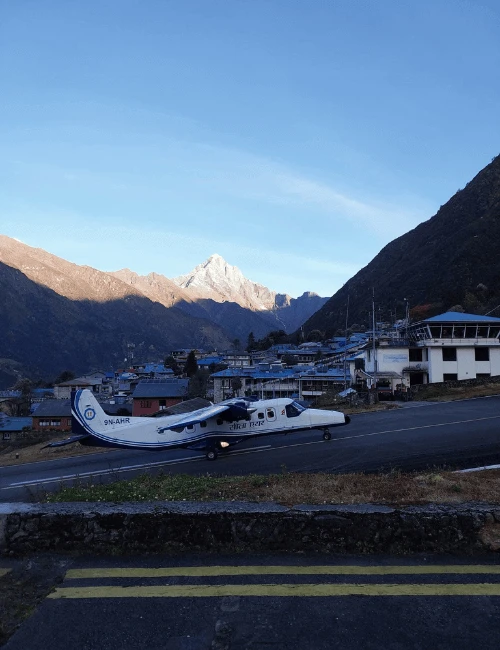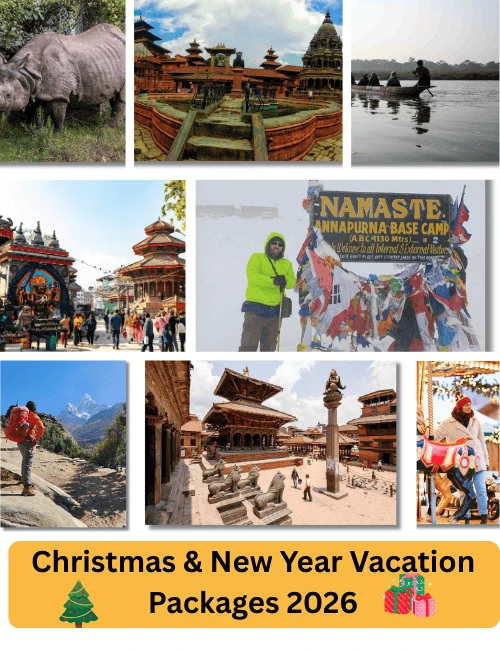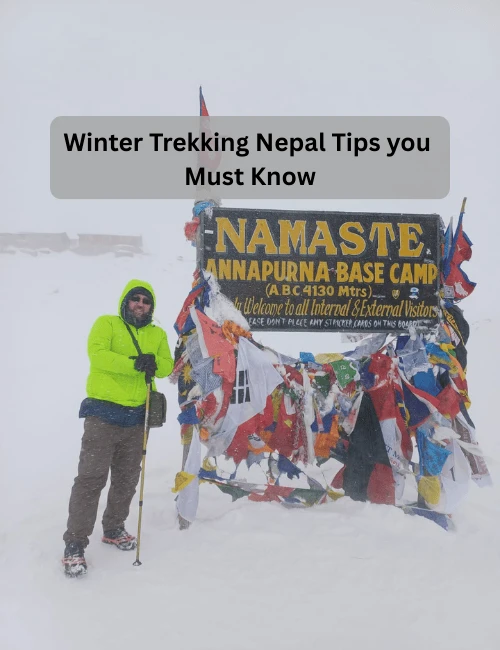The Langtang Valley Trek offers an incredible mix of natural beauty, cultural richness, and adventure – all within a convenient and less crowded package. From the jaw-dropping views of peaks like Langtang Lirung to the warm welcomes in Tamang villages, every day on the trail brings a new reason to fall in love with Langtang. Find out how the Langtang Trek offers an off-the-beaten-path experience that’s less crowded yet equally rewarding.
5 Reasons to go on the Langtang Trek
Explore Reasons to Go on the Langtang Trek in Nepal
If you’re looking for an unforgettable Himalayan trek that combines breathtaking scenery, vibrant culture, and accessible adventure, the Langtang Valley Trek is the perfect choice. However, there are countless reasons to go on the Langtang Trek, but the only way to truly experience it is to visit it by yourself.
The Langtang Trek in Nepal offers a unique experience with many compelling reasons to visit. Nestled just north of Kathmandu, this trek rewards you with towering snow-capped peaks, authentic mountain villages, and abundant wildlife.
Below, we delve into why Langtang Valley is worth trekking, especially after the 2015 earthquake, and how it compares to the Everest or Annapurna treks. We’ll also cover key highlights, from the Langtang Lirung viewpoint to Tamang culture, and address common FAQs to help you plan your adventure.
Why is Langtang Valley worth trekking?
Spectacular Mountains above 7000 meters
Langtang Valley is popular for its dramatic mountain vistas. You will get to see the famous Langtang Lirung (7,227 m) and other towering peaks. As you ascend toward Kyanjin Gompa (3,870 m), snow-capped summits surround the valley. For the best panoramic views, you can hike up to Kyanjin Ri (4,773 m) or Tserko Ri (4,983 m), two famous viewpoints that offer stunning sunrise scenes over the Himalayas.
From these high points, you’ll witness a 360° Himalayan spectacle, including Langtang Lirung’s glaciated face glowing in the morning sun and distant giants like Ganesh Himal and even Annapurna on the horizon. In short, Langtang provides all the alluring mountain views of a great Himalayan trek without the need to trek for weeks on end.
Rich Tamang Cultural Experience
Trekking through Langtang is not just about nature – it’s also a journey through the unique Tamang culture of Nepal. The valley is home to the Tamang people, an ethnic group with Tibetan roots, along with other communities like the Yolmo and Bhotiya.
As you pass through villages such as Langtang, Mundu, and Kyanjin, you’ll encounter warm hospitality and centuries-old Buddhist heritage. Colourful prayer flags, chortens, mani stone walls, and quaint monasteries line the trail.
Kyanjin Gompa, a monastery village at the trek’s end, is a highlight – you can see monks performing rituals and even visit the local cheese factory established with Swiss assistance decades ago. Interacting with locals offers a window into unspoiled culture: villagers may share stories by the hearth, and you can taste local delicacies like yak cheese and butter tea. This authentic cultural immersion is a big part of what makes the Langtang Valley Trek special.
Abundant Wildlife in Langtang National Park
The Langtang trek leads you through Langtang National Park, Nepal’s first Himalayan national park. The trail winds through dense forests of oak, bamboo, and bright rhododendrons (especially stunning in spring).
Trekking quietly, you have a chance to spot wildlife that the park protects. Langtang is famous for elusive red pandas, Himalayan black bears, troops of gray langur monkeys, mountain goats like Himalayan tahr, and even the occasional snow leopard in higher reaches. Bird lovers will enjoy sightings of colourful pheasants and large birds of prey circling overhead.
Best Short and Easy Trek in Nepal
One of the practical reasons to go on the Langtang trek is its easy accessibility and manageable length. The trek itself is relatively short (typically one week of walking), yet it packs in diverse scenery and altitude gain up to 3,800 m at Kyanjin Gompa.
That gradual ascent and moderate high point make it easier to acclimatise and complete than higher-altitude treks. If you’re reasonably fit and can walk 5–6 hours a day, you can tackle Langtang without issue. In fact, it’s considered a beginner-friendly trek in Nepal, known for its gentle pace and safe, well-established route.
Reasons to trek in Langtang after the earthquake
In April 2015, a devastating earthquake struck Nepal and hit the Langtang region particularly hard. Landslides wiped out Langtang Village, and many lives were lost in this valley. You might wonder why trek here after such tragedy – but in fact, there are powerful reasons to do so.
Firstly, the region has made a remarkable recovery. Over the past years, local people have rebuilt their villages and teahouses stronger than before, just slightly north of the old Langtang Village site. Today, the trails are open and safe, and trekkers have been welcomed back to Langtang.
Secondly, the valley’s natural beauty endures. Despite the earthquake’s impact, Langtang’s majestic mountains, glaciers, and forests remain as stunning as ever – no force of nature could take that away. Standing in rebuilt Langtang Village and gazing at the towering cliffs and peaks, you appreciate the valley’s awe-inspiring scenery even more, knowing what was overcome.
The cultural spirit also remains strong. Locals are incredibly welcoming to trekkers now; since tourism dropped dramatically after 2015, villagers are grateful for each visitor and often go the extra mile to make you feel at home. This means more personal interactions, genuine hospitality, and a sense of camaraderie on the trail that you might not find in busier regions.
Finally, improved facilities are an unexpected silver lining. Many lodges along the route have been newly constructed or renovated in recent years. You’ll find clean, comfortable teahouses – some even with perks like solar-heated hot showers and better amenities, which are a real joy in the mountains.
Overall, the Langtang Valley Trek is safe now and open to all levels of hikers. Trekking here not only offers the same great adventure but also lets you witness a story of resilience. The reasons to trek Langtang after the earthquake boil down to this: you’ll experience an incredible trek while making a positive impact, and that combination is hard to beat.
Is Langtang Trek less crowded?
Yes – Langtang is far less crowded than Nepal’s more famous trekking routes. Since the earthquake, the Langtang region has seen a dramatic drop in tourist numbers. Although hikers are returning, the trails are still blissfully quiet compared to Everest Base Camp or Annapurna.
What does a less crowded trek mean for you? It means more tranquillity in nature – you can truly soak in the sounds of birds and rivers. You’ll also have better opportunities to connect with local people. Tea house owners and villagers, who aren’t overwhelmed by tourist traffic, often take time to chat, share stories, and ensure you’re comfortable.
The whole experience feels more authentic and less commercialised. Moreover, finding accommodation is easier, and there’s a cosy camaraderie among the few trekkers who do meet on the trail. In short, the Langtang Valley Trek is a perfect choice if you prefer peaceful trails and a close-to-nature vibe. It is rightly known as one of the best, less crowded treks in Nepal, offering solitude and unspoiled beauty that can be hard to find on the busier circuits.
Why choose Langtang over Everest or Annapurna?
With so many great treks in Nepal, what makes the Langtang Trek a compelling choice versus the legendary Everest Base Camp (EBC) or Annapurna treks? Here are several reasons:
Easy Access, best trek near Kathmandu: Langtang is conveniently located close to Kathmandu. Unlike the Everest Base Camp Trek, it does not require a flight. You can reach the Langtang trailhead by road, driving for 6-7 hours.
Best Short trek with less difficulty: The Langtang Valley Trek typically takes about a week of trekking, which is much shorter than the 12–14 days often needed for EBC or the Annapurna Circuit. If you have limited time or prefer a moderate adventure, Langtang is ideal. The maximum elevation on Langtang (around 3,800 m at Kyanjin, or 5,000 m if you hike a viewpoint) is lower than Everest Base Camp (5,364 m) or Annapurna’s Thorung La pass (5,416 m). Even the Langtang Valley Short Trek 5 Days can be done with no difficulties and hassles.
Fewer Crowds in Langtang: The Langtang Trek in Nepal is less crowded than the popular Everest and Annapurna. The tranquil atmosphere in Langtang lets you feel like you have the mountains almost to yourself – an increasingly rare perk.
Authentic Culture and Community: Each region in Nepal has its own culture – Everest is predominantly Sherpa, and Annapurna has Gurung/Thakali in many areas. The Tamang people’s Tibetan Buddhist traditions in Langtang are still intact and unspoiled by modernisation. Visiting their villages offers a more intimate cultural exchange. You’ll see how people live a traditional mountain lifestyle – tending yaks, spinning prayer wheels, farming – and you might even be invited into their kitchens for a cup of yak butter tea.
Budget-Friendly Option: Trekking in Langtang is generally more affordable than trekking in the Everest or Annapurna regions. Why? For one, you don’t have to pay for costly domestic flights. The Average Langtang Valley Trek cost starts from USD 500 to 800 per person.
In summary, Langtang Valley Trek stands out as an excellent alternative to Everest or Annapurna, especially if you value accessibility, fewer crowds, cultural intimacy, and a lower-cost adventure. It’s a chance to see a quieter side of the Himalayas without missing out on any of the magic.
FAQs of Reasons to Trek in the Langtang Valley
Is Langtang Trek safe to visit now?
Yes, the Langtang Trek is safe to undertake now. After the 2015 earthquake, extensive efforts were made to rebuild and reroute the trail where necessary, and teahouses have been relocated to safer areas. In fact, by now the Langtang region has completely recovered from the earthquake’s damage. In short, you can trek Langtang with confidence – it’s open for adventure and eagerly welcoming trekkers again.
How long is the Langtang Valley Trek?
The Langtang Valley Trek typically takes about 7 to 10 days to complete, depending on your exact itinerary and pace. The standard route – from Syabrubesi to Kyanjin Gompa and back – is often done in around 7 or 8 trekking days (not including any extra travel or rest days). This usually covers a distance of roughly 70 to 80 kilometres round-trip (about 43–50 miles) on foot.
Can beginners do the Langtang Trek?
Absolutely. The Langtang Valley Trek is often recommended as the best short and easy treks in Nepal for beginners. It is a moderate trek in terms of difficulty – there are some steep ascents and high-altitude sections, but nothing technical, and the altitude (max 3,800 m sleeping elevation) is manageable with proper pacing.
What is special about Langtang Valley?
Langtang Valley is often called the “Valley of Glaciers” and holds a special place due to its unique blend of natural and cultural treasures. Culturally, Langtang is extraordinary because it is a stronghold of Tamang and Tibetan heritage, so close to Kathmandu. Moreover, Langtang National Park adds to the valley’s special character – it was Nepal’s first Himalayan national park, known for protecting rare species like the red panda. In one trek, you can experience high Himalayan panoramas, deep forests with wildlife, authentic mountain village life, and even a famous local cheese factory at Kyanjin.
How to reach Langtang from Kathmandu?
To reach Langtang from Kathmandu, you have to drive from Kathmandu to Syabrubeshi by Local Bus or Private Jeep.
Does Langtang Trek need a guide?
As of 2023, Nepal has implemented new regulations that require foreign trekkers to have a licensed guide for treks in national parks, including Langtang. This means that technically, yes, you do need a guide for the Langtang Trek. Beyond the legal requirement, it’s highly recommended to trek with a guide in Langtang. A local guide will not only navigate the trail and handle permits/checkpoints, but also greatly enrich your experience – they can explain cultural sites, help you interact with locals, point out wildlife, and manage any logistical issues.
Conclusion
The Langtang Trek in Nepal has more reasons to visit than those Himalayan vistas, wildlife, and authentic Tamang Culture. Trekking to this valley provides you with a deep connection with nature and creates lifelong memories.
Mountain Eco Trails is here to turn your Langtang trek dream into reality. As a Nepal-based trekking specialist, we can take care of all the details – from permits and transportation to experienced guides who know Langtang inside out. For more details, feel free to contact us via email or WhatsApp us at +9779849790153.



.webp)


